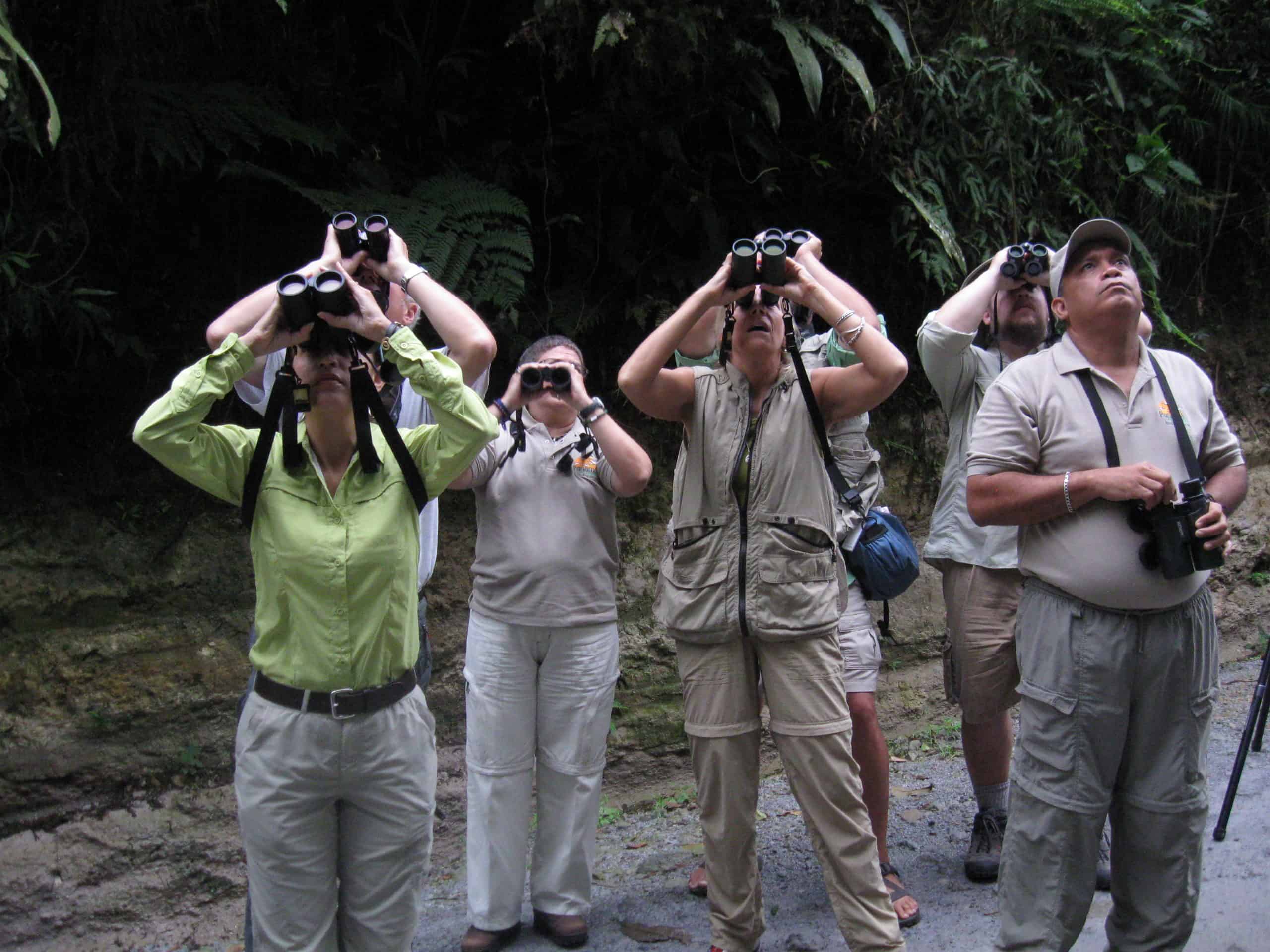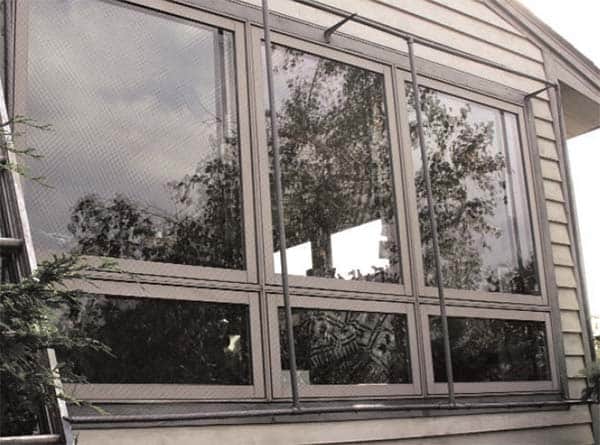With proper technique, your birding can be a source of great joy, rather than a pain in the neck.
Birders joke about it every spring, that period when we experience aches and pains in the neck and shoulders. Warbler neck is caused by looking up into the treetops with binoculars for extended periods. It is a minor inconvenience to some, a source of chronic pain for others. Symptoms may include any combination of neck stiffness, aches, dizziness, tingling in the arms and hands, and sharp pains. Regardless of its severity, it can impede your birding in the very least, and in the worst cases, lead to serious complications.

The Cause
The neck is made up of the seven cervical vertebrae with rubbery disks of cartilage in between. The spinal cord runs through a channel in the vertebrae, and nerves branch out from the spinal cord through spaces between the bones. Bundles of ligaments and muscles surround the structure, adding strength and mobility.
It is normal for people older than the age of 40 to experience a gradual wearing down of the disks between the vertebrae. This wear decreases the amount of space between the bones and can cause pinching of the nerve branches. Calcium deposits on the bones can create rough edges that in turn irritate surrounding soft tissue. The condition is known as cervical arthritis, cervical spondylosis, or facet syndrome. Many people with this condition show no symptoms. Some find that the condition is aggravated by bending the neck back, a common practice when birding.
Prevention
The best way to avoid the ill effects of warbler neck is to prevent the condition in the first place. Many people are unaware of how they use their bodies. By making a few minor adjustments to the way you stand and move, you can prevent much of the discomfort associated with a long day of birding.
The posture typical of many birders is a big part of the problem. The lower back is arched, the upper back is hunched over, and the neck is sharply bent back. This posture creates compression in all three areas. The shoulders are drawn up to the ears, creating even more tension in the neck. The binocular eyepieces are pressed firmly into the eye sockets requiring the entire head to move in order to shift the gaze.
Lauri Elizabeth is an instructor of the Alexander technique, a method of using your body efficiently and maintaining proper spinal alignment.
Elizabeth encourages birders to create a single gentle arch from their feet to the top of their head. Using this technique, your improved posture helps alleviate the stress on your body. One foot is slightly ahead of the other, and the hips are gently tucked under to prevent the lower back from arching too much. The shoulders are down and back, thus eliminating a hunched upper back and allowing the neck to extend upward and gently back. The eyes are looking up through tilted binoculars, allowing the head to remain closer to upright, thus reducing the amount of pinching in the back of the neck.
Simply being aware of your posture will often prevent warbler neck. Think of lengthening your spine upward before bending in any direction. Consciously allow your shoulders to drop down and back, keeping your neck long and relaxed and your upper back straight. Tucking your hips and engaging your abdominal muscles will reduce the amount of arch in your lower back, providing more support for your upper body.
Experiment with various ways of carrying your binoculars. Despite the claims of manufacturers, most binoculars are heavy when being carried all day. Bearing that weight on the back of your neck may aggravate muscles that are already strained.
If you use a neck strap, it should be wide and made of Neoprene. A wide strap distributes the weight over a broader area and the bouncy Neoprene material absorbs much of the shock from the binoculars bouncing with each step.
Shoulder harnesses distribute the weight of your binoculars across your shoulders and back. This is much more comfortable to most people. The disadvantage of shoulder harnesses is that you have to remove them in order to add or remove layers of clothing. A shoulder harness may also prevent you from wearing your binoculars when in the car, because the car’s safety belt interferes with the binocular harness.
Some birders, including myself, hang their binoculars from a long strap over one shoulder. This puts the weight of the binoculars on top of the shoulder, rather than on the back of the neck. You also have the option of switching shoulders, which should be done frequently. As always, wider straps are more comfortable than thin ones, but Neoprene does not work in this situation. The strap must be slick enough to slide easily over your shoulder as you bring your binoculars up.
Strategic positioning is another way to prevent warbler neck. Be aware of your surroundings and position yourself accordingly. Just as you try to keep the sun at your back for best viewing, try to find vantage points that don’t require you to look straight up. Trails that run along hilltops or ridges often allow easy viewing into the treetops below you. Bridges and observation towers also provide a higher vantage point. When working a forest edge, step out away from the edge far enough to give you a gentler angle when scanning the canopy.
If you have to look straight up for any length of time, such as at a hawk- watch site, lie down on your back. This takes all the pressure off your neck and provides a more stable image in your binoculars.
Make sure you maintain proper hydration. Drinking plenty of water helps prevent the aches associated with dehydration and helps the body remove lactic acid, the cause of achy muscles after a workout.

Looking to Subscribe?
Get 6 print issues of the magazine delivered to your door & free digital access
One Year Print Subscription: $26
(to US or Canada, includes digital access)
One Year Digital-only Subscription: $15
Treatment
Despite your best posture and technique, a day of birding may still create stiffness and pain. Some simple stretching exercises can relieve your discomfort and prevent the pain from worsening from day to day. Here are a few examples of stretches you can try. The stretches can be done from either a seated or standing position, but sitting is easier on your back and allows a more effective stretch. Be aware of your own body as you try these. As a general rule, if it hurts, you shouldn’t do it.
Head Rolls: With your shoulders down and back, imagine your neck lengthening upward. Lower your head to your chest. Breathe deeply as you slowly roll your head all the way around one direction, then the other direction. If, as your head goes back, you feel an uncomfortable pulling around your throat, allow your jaw to drop open. As your head rolls around, be aware and careful of any areas that pinch or catch.
Forward Stretch: Grasp the back of your head with your right hand, with your elbow in front of your face. Turn your head 45 degrees to the right and gently pull your head down toward your right leg. Keep your back straight and your shoulders down. Holding the bottom of your chair with your left hand helps to keep your shoulder down and allows a better stretch. Hold this pose for about 15 seconds, keeping your eyes open and your breath flowing. Feel the stretch in the muscles on the left side of the back of your neck. Gently release your head to an upright position and repeat on the left side.
Side Stretch: Place your right hand on top of your head, with your right elbow pointing to the side. Grasp the bottom of your chair with your left hand (or hold a heavy object at your side if you are standing) as you gently pull your head to the right. You should feel the stretch down the left side of your neck into your left shoulder. Keep your eyes open and breathe deeply. Hold for 15 seconds, slowly return your head to an upright position, and repeat on the other side.
Traction: Lie across a bed on your stomach with one pillow under your pelvis and another under your ankles. Allow your head to hang forward over the edge of the bed. This applies about eight pounds of traction to your neck. Imagine the weight of your head gently lengthening your neck and stretching the muscles. Lie in this position for several minutes, but do not fall asleep in this position because it may close off your airway. When you are done stretching, slowly roll onto your side and rest there for a few seconds before attempting to get up. Getting up too quickly may cause you to retighten the muscles you just stretched, and may cause dizziness or lightheadedness.
If your level of discomfort is greater than just an occasional ache or stiffness after a day of birding, you might consider seeing a health care professional. A complaint of warbler neck will probably elicit either a blank stare or a bemused smirk from your family doctor, but it is better to be safe. After an examination to eliminate the possibility of a more serious condition, your doctor may recommend anti-inflammatory drugs such as aspirin or ibuprofen.
You may also benefit from spinal adjustments administered by a chiropractor. Chiropractic care should be the first choice for those who want to avoid taking anti-inflammatory drugs. Massage therapy or physical therapy may relieve the pain of warbler neck, but if a cervical joint is out of alignment, the relief will be temporary.
Warbler neck, although most common during spring migration, can occur any time. Even if your symptoms are very mild, making the effort to prevent the condition and minimizing its duration will make your birding more enjoyable and provide lasting health benefits. Practice good posture, and take the time to stretch before, during, and after a long day in the field. Occasionally a bird will appear directly overhead and force you into an uncomfortable position. But with proper technique, your birding will be a source of great joy, rather than a pain in the neck.




